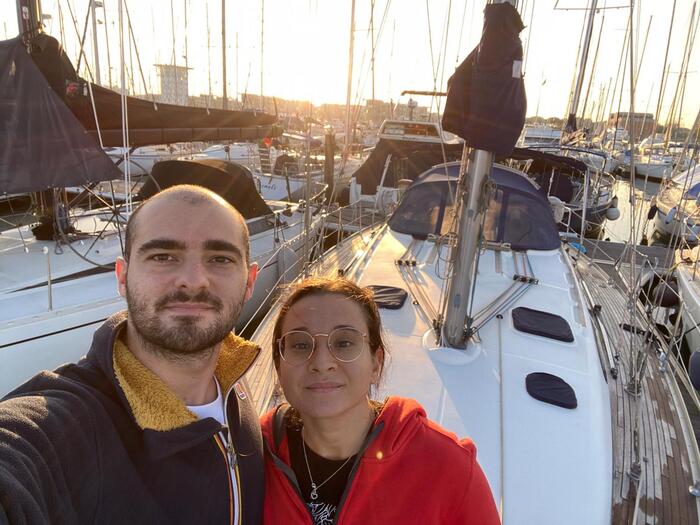The milestones of the covid-19 two years after the start of the pandemic 0:50
(CNN) -
Even after COVID-19 cases drop from their current record highs, the United States, much less the entire world, is unlikely to completely eliminate the coronavirus that causes them.
But there will come a day when it is no longer a pandemic, when cases are no longer out of control and hospitals are not at great risk of overflowing patients.
Many experts predict that the spread of the coronavirus will end up looking more like the seasonal flu.
How do you know if it is a cold, flu or covid?
Experts explain the differences
According to some experts, it is possible that the United States will exceed the peak of omicron cases by the end of January;
2022 may be the time when the coronavirus becomes "part of our background and it comes and goes," Dr. Ofer Levy told CNN's Alisyn Camerota this week.
"I think we are likely to see this wave come and go and that spring and summer will be much better than it seems to us now," said Levy, director of the Precision Vaccine Program at Children's Hospital Boston.
"There will be fewer cases and, in addition, next fall and winter we will register a peak in viral diseases, coronavirus, flu and others, but it will be more of an endemic cycle."
"It will be a better winter, just as this winter, with all the challenges, is still better than the last."
advertising
But this coronavirus frequently changes and surprises, and there is no official benchmark for when the pandemic has ended and a so-called "new normal" has begun.
2022 may mark the end of the pandemic, says WHO director
"There is not even a measure to say that something is an epidemic or a pandemic. This is all in the eye of the beholder, and that's part of the problem," Dr. Arnold Monto, professor of epidemiology at the United States, told CNN in November. University of Michigan and Acting Chairman of the US Food and Drug Administration (FDA) Advisory Committee on Vaccines and Related Biologicals.
"So all of this is not rule-based. It is usually based on what needs to be done to control the outbreak," Monto said.
"What is so different here is that our vaccines are much more effective than what we usually see."
That's the good news, according to Monto.
The bad news comes with the virus's power to change and evolve.
No one can predict what the future of covid-19 might look like, and the emergence of variants of the coronavirus, such as delta and omicron, has changed the trajectory.
"With the shift in transmission patterns, as variants have emerged - I call it a parade of variants - we now see much more extensive transmission and much more uniform spread globally. This makes it more difficult declare the end of the pandemic, "Monto said.
"Because the whole pattern of spread has changed, and there may still be pockets that haven't really gone through the kind of waves that the rest of the world has gone through."
Is the final stretch of the pandemic in sight?
Specialist answers 1:13
Wait, see and be patient
Monto and other public health leaders predict that in the future the world could follow the spread of SARS-CoV-2, the coronavirus that causes Covid-19, in a similar way to how seasonal flu is monitored.
"We have no idea if we're going to see that kind of seasonal pattern with SARS-CoV-2, but it reminds us that most of our respiratory viruses start to behave like seasonal events," Monto said.
"There is a precedent for a very seasonal pattern for some of the coronaviruses that have infected people," he added.
"We don't know if SARS-CoV-2 will start to behave like this, but at least it gives us at least one scenario where it could start to do so."
In Monto's words, we have to "wait and see and be patient" to unravel what an endemic phase of the coronavirus might look like.
Covid-19 Could Turn Seasonal Disease Eventually, Scientists Say
Endemic means that a disease has a constant presence in a population, but does not affect an alarming number of people, as is often the case in a pandemic.
Even in early 2020, when the pandemic had just escalated, World Health Organization officials predicted that the new coronavirus "may become another endemic virus in our communities" and never go away.
"When you think about pandemics, you are in the pandemic phase, and then you have a slowdown phase, then you have a control phase, and then you hope to have elimination and maybe eradication," said Dr. Anthony Fauci, director of the National Institute of Allergy and Infectious Diseases, at a hearing in the US Senate on Health, Education, Work and Pensions in November.
"What we hope to achieve is such a low level that, even if it is not completely eliminated, it does not have a major impact on public health or the way we lead our lives," Fauci said.
"So if we get more people to get vaccinated globally and more people to get vaccinated now, we hope that in a reasonable amount of time, we will get to that point where it may occasionally go up and down on the bottom, but it won't get the better of us. the way he's doing it now. "
Even as COVID-19 cases reach new highs, federal health authorities have been thinking about how to measure the end of the pandemic and how to continue to monitor the coronavirus once it is endemic.
There's still much to do
To move from a pandemic phase to an endemic infection, the country has to build immunity against the coronavirus, which means that many more people must be vaccinated, Dr. Philip Landrigan, a pediatrician and epidemiologist from the United States, told CNN in November. Boston College.
With some Americans still refusing to get vaccinated against COVID-19 and some refusing to wear masks, the transition could take longer.
Covid-19 devastated Latin America in 2020, and now its vaccination rates exceed those of Europe and the United States
About 62% of the total US population is fully vaccinated against COVID-19.
Even fewer have received a booster dose.
"We have to get to a level well above 80%, possibly even 90% of the population with immunity, either from having the infection or from having been vaccinated," said Landrigan, who worked at the CDC for 15 years.
To control the spread of the measles virus in the US population, for example, "we had to get the immunity rate to exceed 95%, and even then we have had sporadic outbreaks."
These outbreaks usually occur when there is a group of people in a specific place who are not immunized and, suddenly, the virus is introduced because a traveler arrived with the virus, and, bang, you have 20 cases of measles in some city ", Landrigan said. "But that's not an epidemic.
It is an outbreak in a context of almost no cases or scattered endemic cases. "
Health authorities are familiar with the work required to improve vaccination rates.
The CDC recommends that almost everyone over the age of 6 months get a flu shot each year.
But during the 2019-20 flu season, only half of those people - 51.8% - did so, according to the CDC.
The agency estimates that the flu has caused between 12,000 and 52,000 deaths each year between 2010 and 2020.
The coronavirus has so far killed more than 800,000 people in the United States.
In the future, the battle to corner the virus each year may look a lot like the annual fight against the flu.
"We've been thinking a lot about what an endemic phase looks like and the data that we have to collect during that phase. Certainly right now we are collecting data on cases, hospitalizations and deaths," said Dr. Rochelle Walensky, director of the CDC, at the Senate committee hearing in November.
"The question is: what will be our best metrics to move forward? And we will probably model it based on the flu."
ANALYSIS |
Another year marked by the covid-19 pandemic ends in darkness, but there is hope on the horizon
A more likely picture of the future
CDC works with health departments, laboratories, hospitals, and healthcare providers to track diagnosed flu cases, determine which flu viruses are circulating, and measure the impact those viruses are having on people. hospitalizations and deaths.
The idea is that when the coronavirus becomes endemic, a similar monitoring system can be used to control it.
"We could handle cases like we do with seasonal flu, where we are able to say that we are going to record a number of cases in the winter season, and we can have the right staff, we can have the right supplies ready, and we are ready to go. handle it, unlike the waves we've been dealing with here, "Dr. Stephen Parodi, Kaiser Permanente's National Infectious Diseases Leader, told CNN in November.
"I'm still on phone calls talking about 'what is our bed capacity in the Intensive Care Unit? What is our supply chain that we need to care for patients? Do we have enough medications?" Parodi said.
"We still have a lot of work to do to get to where we want to be, and I think we will see this transition throughout the year 2022. But for some places, where there is less immunity, it will be a longer race."
Even the flu is unpredictable, and doctors have come across it a lot over the years.
"We know there are going to be cases," Monto said.
"With the flu, we've had experience with flu pandemics before. So we know their typical behavior. This has been an evolutionary situation with a totally novel pathogen."
- CNN's Jamie Gumbrecht contributed to this report.
omicron








